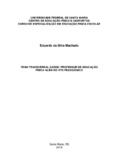| dc.contributor.advisor | Daronco, Luciane Sanchotene Etchepare | |
| dc.creator | Machado, Eduardo da Silva | |
| dc.date.accessioned | 2018-07-04T14:46:55Z | |
| dc.date.available | 2018-07-04T14:46:55Z | |
| dc.date.issued | 2018-05-14 | |
| dc.date.submitted | 2018 | |
| dc.identifier.uri | http://repositorio.ufsm.br/handle/1/13644 | |
| dc.description | Monografia (especialização) - Universidade Federal de Santa Maria, Centro de Educação Física e Desporto, Curso de Especialização em Educação Física Escolar, RS, 2018. | por |
| dc.description.abstract | The objective of this study was to investigate the competences to teach health at scholar physical education, during the final years of elementary school, according to the Parâmetros Curriculares Nacionais (1998) and the Base Nacional Comum Curricular (2017). It happened through bibliographical research in literature review and documentary analysis, through the identification of the term health and its frequency in national curricular references. The results showed that the curricular references guide physical education in seven categories: 1) importance and the relations between health and physical education; 2) standards of beauty, health and performance; 3) physical activity, physical exercise and sports practices in health; 4) autonomy for the practice of leisure and health; 5) to reflect and to demystify the health; 6) ways of approaching the theme health; 7) gymnastics and health. From the data analysis, it was possible to detect that the curricular references recognize the importance of the study of health in physical education, highlighting several reflections, possibilities and recommendations for the curricular component. Although Parâmetros Curriculares Nacionais offer more information than the Base Nacional Comum Curricular, the ideal is that both documents be consulted, in the form that an aggregate knowledge to the other, a process that aims at the broader view on this transversal theme. In this way, it is up to the teacher to study, to formulate and to adapt new curricula in the reality that it is inserted, in the conjuncture with the promotion of health and citizenship. | eng |
| dc.language | por | por |
| dc.publisher | Universidade Federal de Santa Maria | por |
| dc.rights | Acesso Aberto | por |
| dc.rights | Attribution-NonCommercial-NoDerivatives 4.0 International | * |
| dc.rights.uri | http://creativecommons.org/licenses/by-nc-nd/4.0/ | * |
| dc.subject | Educação física | por |
| dc.subject | Saúde | por |
| dc.subject | Educação | por |
| dc.subject | BNCC (Base Nacional Comum Curricular) | por |
| dc.subject | Physical education | eng |
| dc.subject | Health | eng |
| dc.subject | Education | eng |
| dc.title | Tema transversal saúde: professor de educação física além do ato pedagógico | por |
| dc.title.alternative | Transversal theme health: teacher of physical education beyond the pedagogical act | eng |
| dc.type | Trabalho de Conclusão de Curso de Especialização | por |
| dc.degree.local | Santa Maria, RS, Brasil | por |
| dc.degree.specialization | Educação Física Escolar | por |
| dc.description.resumo | O objetivo deste estudo foi averiguar as competências para ensinar a saúde na educação física escolar, durante os anos finais do ensino fundamental, conforme os Parâmetros Curriculares Nacionais (1998) e a Base Nacional Comum Curricular (2017). Isto ocorreu, através da pesquisa bibliográfica na revisão de literatura e na análise documental, por meio da identificação do termo saúde e a sua frequência nos referenciais curriculares nacionais. Os resultados demonstraram que os referenciais curriculares orientam a educação física escolar, em sete categorias: 1) importância e as relações entre saúde e educação física; 2) padrões de beleza, saúde e desempenho; 3) atividade física, exercício físico e práticas desportivas na saúde; 4) autonomia para a prática do lazer e da saúde; 5) refletir e desmistificar a saúde; 6) formas de abordar a saúde; 7) ginástica e a saúde. A partir da análise de dados foi possível detectar que os referencias curriculares reconhecem a importância do estudo da saúde na educação física, destacando várias reflexões, possibilidades e recomendações para o componente curricular. Embora os Parâmetros Curriculares Nacionais ofereçam maior volume de informações do que a Base Nacional Comum Curricular, o ideal é que ambos os documentos sejam consultados, na forma que um agregue conhecimentos ao outro, a fim que se atinja uma visão mais ampla sobre este tema transversal. Dessa maneira, cabe ao professor estudar, formular e adequar novos currículos na realidade que está inserido, na conjuntura com a promoção da saúde e da cidadania. | por |
| dc.publisher.country | Brasil | por |
| dc.publisher.initials | UFSM | por |
| dc.subject.cnpq | CNPQ::CIENCIAS DA SAUDE::EDUCACAO FISICA | por |
| dc.publisher.unidade | Centro de Educação Física e Desportos | por |



